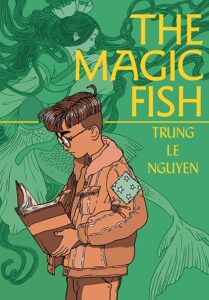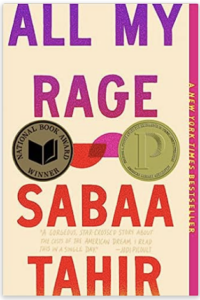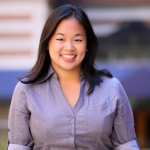This blog post was written by NCTE member Diana Liu in collaboration with her students, Arham Piracha, Hannah Chiang, and Mohammed Afshin. This post is part of Build Your Stack®, an NCTE initiative focused exclusively on helping teachers build their book knowledge and their classroom libraries. Build Your Stack provides a forum for contributors to share books from their classroom experience; inclusion in a blog post does not imply endorsement or promotion of specific books by NCTE.
Rudine Sims Bishop (1990) illuminates the power of literature to be “windows” and “sliding doors” for readers to see reflections of themselves and position themselves within the larger human experience (“Mirrors, Windows, and Sliding Glass Doors,” para 1). Although this reflection of selves within texts is self-affirming, a mere “celebratory approach to diverse manifestations” may neutralize the way literature is framed within current sociocultural positions and “risks a significant silence regarding the ways in which texts live in, shape, and are shaped by the world” (Brauer and Clark 2008, 294).
Literature can function as a political medium in which individuals are able to realize alternative frames of view and choices that may not be recognized inherently within their current dominant societal structure. As a result, should students be exposed to literature that does not reflect dominant cultural and political conceptions, and with what framework? Rosenblatt (1965) answers this question by stating that students should not be restricted to a “literary diet” and the wider the exposure, the more liberating of a force it becomes for the student (204).
In response to a growing multicultural classroom and to expand teachers’ and students’ “literary diet,” Viet Thanh Nguyen (2018) introduces the concept of “narrative plentitude,” which defines the need for more narratives, especially for Asian Americans in mainstream culture, so that we can continue shaping our understandings of people beyond singular stories. Similarly, Thomas (2016) adds that while diversity in literature is necessary, there also needs to be emphasis on how representation appears in texts so that there is not a perpetuation of marginalization, stereotyping, and characterization.
In order to disrupt the way we select and teach literature in the classroom, we also borrow concepts from Youth Participatory Action Research (YPAR) that “seeks to disrupt dominant understandings of who gets to identify and practice being an educator, knower, or agent of change, and allows the possibility of a collaborative space where the co-construction of critical knowledges blurs, at least partially, some of the boundaries of agency and identity between students [and] teachers…” (Caraballo & Soleimany 2018, 89). There is power in English language arts (ELA) educators to cultivate with students the ability to critically examine themselves in relation to other matters in the texts that are selected and how they are mindfully taught in the classroom. At the same time, there is also power in students in recognizing their literacies to shape the curriculum with teachers in what is taught and what conversations ensue.
In the effort to increase diversity and inclusion in schools, it is imperative that schools look to teach narratives to which students themselves relate, and in this effort, student input could be really meaningful to the future generation of students.
As a result, this book stack is created through multiple conversations between a high school teacher and her students in hopes of more intersectional teaching that will deepen the way we understand what it means to teach “diverse texts.” Ms. Liu and her students are offering suggestions at the ninth-grade level to begin this journey in high school.
 Anger Is a Gift by Mark Oshiro explores how racial discrimination can be perpetuated by and ingrained in the education system, and society as a whole. It follows the life of Moss Jeffries, a queer African American teenager living in West Oakland, California. Moss suffers from anxiety and panic attacks following the death of his father at the hands of police, six years prior to the start of the novel.
Anger Is a Gift by Mark Oshiro explores how racial discrimination can be perpetuated by and ingrained in the education system, and society as a whole. It follows the life of Moss Jeffries, a queer African American teenager living in West Oakland, California. Moss suffers from anxiety and panic attacks following the death of his father at the hands of police, six years prior to the start of the novel.
Moss initially prefers to not be involved in activism. He avoids protests and rallies, as the mere mention of either invokes a pang of fear in him. However, he reaches a turning point in his life when the local police department collaborates with his high school administration and Moss and his peers are first-handedly faced with blatant systemic oppression. At first, they attempt to tolerate the situation, but as it escalates and becomes something the group can no longer ignore, they band together to fight for justice. They learn to embrace and utilize their anger as a tool for change—as something to channel into positive actions in order to bring about meaningful transformations and to heal in community.
Institutional oppression, racism, homophobia, transphobia—these are all obstacles that the characters face in the novel, and that many people face today in the real world as well. The root of these issues is ignorance, which can be mitigated through raising awareness and understanding. Teaching books such as Anger Is a Gift provides context needed to create a safe space where students can discuss and learn about the convergence of topics such as sexuality, gender, class, and race. It can also inspire them to be more proactive in the fight for change.
[Anger Is a Gift recommended by Arham Piracha and Hannah Chiang]
Trung Le Nguyen’s The Magic Fish is the story of a second-generation Vietnamese immigrant, Tiên, and his mother, Helen. Utilizing Eastern and Western fairy tales as a medium, Nguyen conveys the history of Tiên and Helen’s family, as well as the pair’s journey in navigating the communicative gap that has formed between them as a result of coming from two vastly different worlds.
and Western fairy tales as a medium, Nguyen conveys the history of Tiên and Helen’s family, as well as the pair’s journey in navigating the communicative gap that has formed between them as a result of coming from two vastly different worlds.
Whereas Helen was born in Vietnam toward the end of the Vietnam War, Tiên grew up in the United States in the 1980s. The two of them both understand that they grew up in drastically different environments, with drastically different cultures, and even though they are warm and loving toward one another from the first page of the book to the last, they each grapple with their own hesitations in communication because of this cultural discrepancy. Helen feels that Tiên does not confide in her, and Tiên fears coming out as gay to her would be a burden.
Adolescence is a time period where many start to think about and explore identity—cultural, sexual, spiritual, political, and more. Many students may find that they see themselves in Tiên, or even with Helen. This story is a wholesome, beautifully told, and genuine portrayal of navigating parental immigrant experiences, coming out as part of the LGBTQIA+ community, and an intertwining of cultural narratives.
[The Magic Fish recommended by Hannah Chiang]
 All My Rage by Sabaa Tahir is a novel that depicts the lives of Salahudin and Noor, two Pakistani American high school students. The novel explores the feeling of not belonging to a home through a series of tragedies. Salahudin and Noor, being best friends since childhood, faced similar circumstances when trying to assimilate into a new home in the US. Since their parents were excluded from society, they themselves felt isolated through the lack of opportunities they faced. As a result, they longed for the culture they weren’t able to experience in Pakistan and ended up having difficulties from past trauma and family situations. The characters are able to openly express themselves and the challenges they face, such as the realities of their personal relationships, tensions in achieving the American Dream, and the unfulfilled dreams that come as a result of the cost of the American Dream, through the changes in point of view between the characters and the changes between past and present circumstances in life.
All My Rage by Sabaa Tahir is a novel that depicts the lives of Salahudin and Noor, two Pakistani American high school students. The novel explores the feeling of not belonging to a home through a series of tragedies. Salahudin and Noor, being best friends since childhood, faced similar circumstances when trying to assimilate into a new home in the US. Since their parents were excluded from society, they themselves felt isolated through the lack of opportunities they faced. As a result, they longed for the culture they weren’t able to experience in Pakistan and ended up having difficulties from past trauma and family situations. The characters are able to openly express themselves and the challenges they face, such as the realities of their personal relationships, tensions in achieving the American Dream, and the unfulfilled dreams that come as a result of the cost of the American Dream, through the changes in point of view between the characters and the changes between past and present circumstances in life.
Through the novel, the characters are revealing information they have hidden, and the use of a disclosing tone helps express the characters more openly. Specifically, Noor, who was born in Pakistan, moved to the US as a child after the loss of her family in a tragic accident and experiences her present life with a cruel uncle. On the other hand, Salahudin describes a forgotten trauma that still causes pain in his bones and, in his present life, deals with a father who drinks alcohol from misery and a mother (Misbah) who is close to death from poor health.
Sabaa Tahir illustrates various themes, such as the importance of family and friends as support and the setbacks of the American Dream, to let other immigrants know the importance of culture and the difficulties in immersing in a completely new one. As a result, teachers should teach this novel because it includes many intersectionalities that make it worthwhile for teachers to teach, such as the power of storytelling through different points of view to highlight the importance of culture—in this case, Pakistani culture—and how it makes up the diversity within US immigration, as well as the power of friendship in difficult circumstances that helps solve these problems in life.
This novel showcases the implications of the American Dream, how the complexities within life result in rage for immigrants, and what that rage can do—heal and/or continue damage. Therefore, students can learn from the experiences of these Pakistani American high school students because they’re taught the importance of having support in life when facing difficulties.
Students should read this book because it centers difficulties faced by students and ways they can cope with problems they face in life. It also serves to motivate students to make changes that increase opportunities for first-generation and US-born individuals, allowing them to live in a more inclusive environment and incorporate their cultures effectively. This experience serves as a way for immigrants to feel comfortable and belong in American society, counteracting the longing for the cultures they leave behind.
[All My Rage recommended by Arham Piracha]
 In the memoir, They Call Us Enemy, George Takei depicts the traumatic experience of Japanese incarceration by crafting a graphic novel forged with trauma, pain, resilience, faith, and betrayal by one’s own country: the United States. In this compelling novel, George Takei delves into a deeply traumatizing but historically relevant experience during WWII where he and his family were unjustly imprisoned in incarceration camps. George Takei puts the reader in a time period where hysteria, xenophobia, and erosion of basic civil liberties took over the United States. Supported with phenomenally detailed imagery provided by Harmony Becker, the readers are subjected to see the inhumane treatment and hardships that over 120,000 Japanese Americans faced from the American government. George Takei’s They Call Us Enemy subjugates readers to confront the United States’ troubled past regarding racial discrimination and government-sanctioned injustices to the common people. Through the power of storytelling, Takei illustrates a timeless message of resilience, belief, and the importance of standing up to any oppression. This novel is a must-read memoir for teachers and students because it allows the teacher to depict the importance of historical understanding and demonstrates how students are the fundamental movers for societal change. For students, this memoir is a testament to the strength of the human spirit and reminds students that they must struggle to create a society that is inclusive and nondiscriminatory. It allows students to comprehend the fact that they aren’t just the future, but they are the fundamental bridges that connect the past, present, and the future, and without critical knowledge, such bridges simply do not exist.
In the memoir, They Call Us Enemy, George Takei depicts the traumatic experience of Japanese incarceration by crafting a graphic novel forged with trauma, pain, resilience, faith, and betrayal by one’s own country: the United States. In this compelling novel, George Takei delves into a deeply traumatizing but historically relevant experience during WWII where he and his family were unjustly imprisoned in incarceration camps. George Takei puts the reader in a time period where hysteria, xenophobia, and erosion of basic civil liberties took over the United States. Supported with phenomenally detailed imagery provided by Harmony Becker, the readers are subjected to see the inhumane treatment and hardships that over 120,000 Japanese Americans faced from the American government. George Takei’s They Call Us Enemy subjugates readers to confront the United States’ troubled past regarding racial discrimination and government-sanctioned injustices to the common people. Through the power of storytelling, Takei illustrates a timeless message of resilience, belief, and the importance of standing up to any oppression. This novel is a must-read memoir for teachers and students because it allows the teacher to depict the importance of historical understanding and demonstrates how students are the fundamental movers for societal change. For students, this memoir is a testament to the strength of the human spirit and reminds students that they must struggle to create a society that is inclusive and nondiscriminatory. It allows students to comprehend the fact that they aren’t just the future, but they are the fundamental bridges that connect the past, present, and the future, and without critical knowledge, such bridges simply do not exist.
[They Call Us Enemy recommended by Mohammed Afshin]
References
Brauer, L., & Clark, C. T. (2008). The trouble is English: Reframing English studies in secondary schools. English Education, 40(4), 293–313. http://www.jstor.org/stable/40173289
Caraballo, L., & Soleimany, S. (2019). In the name of (pedagogical) love: A conceptual framework for transformative teaching grounded in critical youth research. The Urban Review, 51(1), 81-100. https://doi.org/10.1007/s11256-018-0486-5
Nguyen, V.T. (2018, October 11). Viet Thanh Nguyen and Vu Tran: “Narrative Plentitude”; Talks at Google. Viet Thanh Nguyen. https://vietnguyen.info/2018/viet-thanh-nguyen-and-vu-tran-narrative-plentitude-talks-at-google
Rosenblatt, L.M. (1965). Literature as Exploration. The Modern Language Association of America.
Sims Bishop, R. (1990). Mirrors, windows, and sliding glass doors. Perspectives, 1(3), ix–xi.
Thomas, E.E. (2016). Stories still matter: Rethinking the role of diverse children’s literature today. Language Arts, 94(2), https://www.jstor.org/stable/44809887
NCTE and independent bookstores will receive a small commission from purchases made using the Bookshop.org links above.

Diana Liu is a public high school English teacher in Brooklyn, New York, and is ENL-certified. She is a PhD student in the English education program at Teachers College, Columbia University, and a 2021 recipient of NCTE’s Early Career Educator of Color Leadership Award. Diana has been a member of NCTE since 2018.

Mohammed Afshin is a rising 10th grader who currently attends a public high school in Brooklyn, New York. He was a student of Ms. Liu’s English language arts class for the academic year of 2022-2023. His current aspirations are to earn a PhD in mechanical engineering.
 Arham Piracha is a rising 10th grader attending a public high school in Brooklyn, New York. He was a student of Ms. Liu’s 9th-grade English language arts class in the academic year of 2022-2023.
Arham Piracha is a rising 10th grader attending a public high school in Brooklyn, New York. He was a student of Ms. Liu’s 9th-grade English language arts class in the academic year of 2022-2023.

Hannah Chiang is a rising 11th grader and student body vice president at a public high school in Brooklyn, New York. She is a student advisor for the school’s Equity Team and was a student of Ms. Liu’s AP Capstone Seminar class in the academic year of 2022-2023.
It is the policy of NCTE in all publications, including the Literacy & NCTE blog, to provide a forum for the open discussion of ideas concerning the content and the teaching of English and the language arts. Publicity accorded to any particular point of view does not imply endorsement by the Executive Committee, the Board of Directors, the staff, or the membership at large, except in announcements of policy, where such endorsement is clearly specified.

